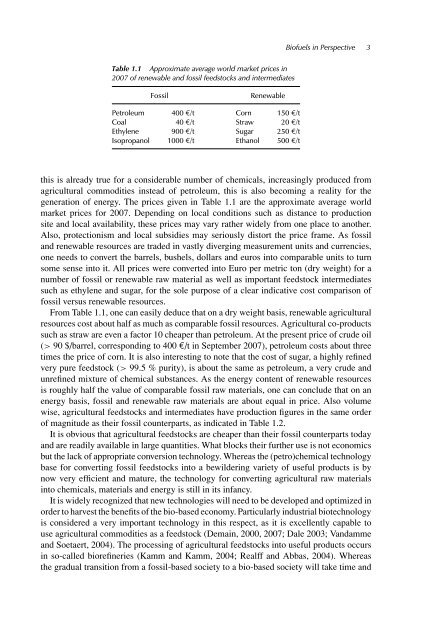Biofuels in Perspective
Biofuels in Perspective
Biofuels in Perspective
You also want an ePaper? Increase the reach of your titles
YUMPU automatically turns print PDFs into web optimized ePapers that Google loves.
Table 1.1 Approximate average world market prices <strong>in</strong><br />
2007 of renewable and fossil feedstocks and <strong>in</strong>termediates<br />
Fossil Renewable<br />
Petroleum 400 €/t Corn 150 €/t<br />
Coal 40 €/t Straw 20 €/t<br />
Ethylene 900 €/t Sugar 250 €/t<br />
Isopropanol 1000 €/t Ethanol 500 €/t<br />
<strong>Biofuels</strong> <strong>in</strong> <strong>Perspective</strong> 3<br />
this is already true for a considerable number of chemicals, <strong>in</strong>creas<strong>in</strong>gly produced from<br />
agricultural commodities <strong>in</strong>stead of petroleum, this is also becom<strong>in</strong>g a reality for the<br />
generation of energy. The prices given <strong>in</strong> Table 1.1 are the approximate average world<br />
market prices for 2007. Depend<strong>in</strong>g on local conditions such as distance to production<br />
site and local availability, these prices may vary rather widely from one place to another.<br />
Also, protectionism and local subsidies may seriously distort the price frame. As fossil<br />
and renewable resources are traded <strong>in</strong> vastly diverg<strong>in</strong>g measurement units and currencies,<br />
one needs to convert the barrels, bushels, dollars and euros <strong>in</strong>to comparable units to turn<br />
some sense <strong>in</strong>to it. All prices were converted <strong>in</strong>to Euro per metric ton (dry weight) for a<br />
number of fossil or renewable raw material as well as important feedstock <strong>in</strong>termediates<br />
such as ethylene and sugar, for the sole purpose of a clear <strong>in</strong>dicative cost comparison of<br />
fossil versus renewable resources.<br />
From Table 1.1, one can easily deduce that on a dry weight basis, renewable agricultural<br />
resources cost about half as much as comparable fossil resources. Agricultural co-products<br />
such as straw are even a factor 10 cheaper than petroleum. At the present price of crude oil<br />
(> 90 $/barrel, correspond<strong>in</strong>g to 400 €/t <strong>in</strong> September 2007), petroleum costs about three<br />
times the price of corn. It is also <strong>in</strong>terest<strong>in</strong>g to note that the cost of sugar, a highly ref<strong>in</strong>ed<br />
very pure feedstock (> 99.5 % purity), is about the same as petroleum, a very crude and<br />
unref<strong>in</strong>ed mixture of chemical substances. As the energy content of renewable resources<br />
is roughly half the value of comparable fossil raw materials, one can conclude that on an<br />
energy basis, fossil and renewable raw materials are about equal <strong>in</strong> price. Also volume<br />
wise, agricultural feedstocks and <strong>in</strong>termediates have production figures <strong>in</strong> the same order<br />
of magnitude as their fossil counterparts, as <strong>in</strong>dicated <strong>in</strong> Table 1.2.<br />
It is obvious that agricultural feedstocks are cheaper than their fossil counterparts today<br />
and are readily available <strong>in</strong> large quantities. What blocks their further use is not economics<br />
but the lack of appropriate conversion technology. Whereas the (petro)chemical technology<br />
base for convert<strong>in</strong>g fossil feedstocks <strong>in</strong>to a bewilder<strong>in</strong>g variety of useful products is by<br />
now very efficient and mature, the technology for convert<strong>in</strong>g agricultural raw materials<br />
<strong>in</strong>to chemicals, materials and energy is still <strong>in</strong> its <strong>in</strong>fancy.<br />
It is widely recognized that new technologies will need to be developed and optimized <strong>in</strong><br />
order to harvest the benefits of the bio-based economy. Particularly <strong>in</strong>dustrial biotechnology<br />
is considered a very important technology <strong>in</strong> this respect, as it is excellently capable to<br />
use agricultural commodities as a feedstock (Dema<strong>in</strong>, 2000, 2007; Dale 2003; Vandamme<br />
and Soetaert, 2004). The process<strong>in</strong>g of agricultural feedstocks <strong>in</strong>to useful products occurs<br />
<strong>in</strong> so-called bioref<strong>in</strong>eries (Kamm and Kamm, 2004; Realff and Abbas, 2004). Whereas<br />
the gradual transition from a fossil-based society to a bio-based society will take time and








